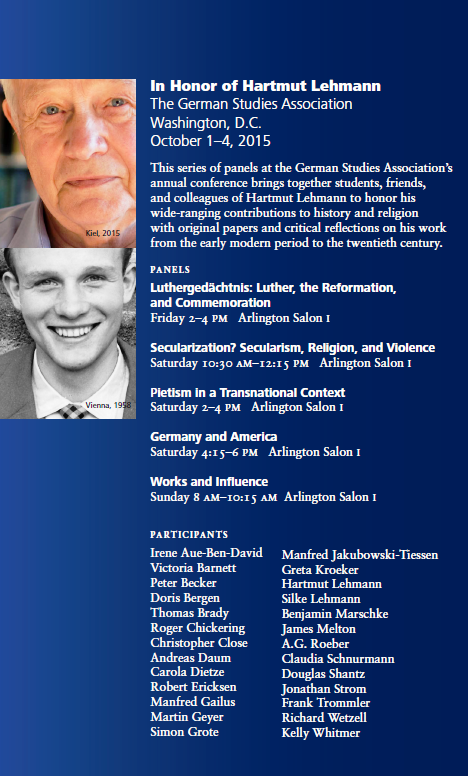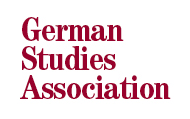Contemporary Church History Quarterly
Volume 30, Number 4 (Winter 2024)
Conference Report: Seminar, Religion and Secularism in Germany from the Nineteenth Century to the Present, German Studies Association, September 2024
By Mark Edward Ruff, St. Louis University
This seminar, which featured 14 participants and 6 auditors, was originally scheduled to convene at the annual meeting of the German Studies Association from September 27-29, 2024. Because of flooding and power outages caused by Hurricane Helene, however, most of the participants were unable to arrive safely in Atlanta in person. The seminar took place instead over Zoom in three sessions of an hour and fifty minutes each.
Convened by Professor Dr. Florian Bock, a church historian at the Ruhr-Universität-Bochum (RUB) and Mark Edward Ruff of Saint Louis University, this seminar explored the complex relationship between religion and secularism in the 19th and 20th centuries. This was a topic that until recently had received relatively little attention from scholars, who simply assumed that the relationship between secularist movements and organized religion in Germany was characterized by mutual hostility.
This hostility certainly existed. Freethinker and secularist movements inveighed against organized religion. Frequently denouncing religion as little more than superstition, they also showed themselves to be rabidly anticlerical in their broadsides against established religious institutions. Predictably, they disproportionately directed their fire against the Catholic church: freethinkers disproportionately arose out of Protestant rinks. To be sure, defenders of orthodox religion often responded in kind. They met hostility with hostility, and for that reason alone, scholars were for decades apt to take as a given mutual animosity between secularism and religion.
But the relationship between religion and secularism was never quite that simple. For one, Catholicism, Protestantism, Judaism, and Islam were anything but homogenous; significant differences existed not only between but within each over how to position oneself in politics, society and the so-called “modern” world with its default assumption of secularity. For another, secularism and secularity were not coherent concepts either. Secularism ran the gamut from laicité and anticlericalism to free-thinking, materialism, agnosticism, and atheism. Its relationship to ostensibly secular parties like the SPD was complicated, since most Germans retained formal religious affiliations through the first two-thirds of the 20th century. Not least, secular ideas emerged out of religious institutions and inquiry and vice versa; religious discussions of gender, sexuality, and capitalism were shaped by complicated interactions with secularist views.
Aiming to explore how religion and secularism defined themselves and each other vis-à-vis the other and its impact on the lives of the faithful, indifferent and skeptical, this seminar put together readings mostly from the first two decades of the 21st century. The first day’s readings sought to make sense of competing understandings of secularism and the secular. They included portions of Talal Asad’s classic work, Formations of the Secular. Christianity, Islam, Modernity (Stanford University Press, 2003) and Charles Taylor’s magnum opus, A Secular Age (Harvard University Press, 2007) along with a set of reflection by the German sociologist, Detlef Pollack, on secularization. Taylor had famously posed the question of why was it virtually impossible not to believe in God in 1500 in the West while in today’s world and especially in the “secular” academy, it is “easy,” if not “inescapable?” Participants pointed out a paradox. Although Asad published his book before Taylor, portions of it were expressly designed to counter Taylor’s arguments and framework of the secular which he had encountered in bits and pieces in the preceding decade. Many participants also noted how both works were profoundly shaped by the attacks of September 11, 2001. How much of these frameworks, they queried, remained viable more than twenty years later?
For the second day of the seminar, participants applied and historicized these theories in greater detail. They discussed Manuel Borutta’s pioneering article, “Genealogie der Säkularisierungstheorie. Zur Historisierung einer großen Erzählung der Moderne,“ which appeared in the German journal, Geschichte und Gesellschaft, in 2010. They also explored portions of Rebekka Habermas’ edited volume, Negotiating the Secular and the Religious in the German Empire. Transnational Approaches (Berghahn Books, 2019), and its chapters on religion in the so-called “long 19th-century.” The attendees also discussed the chapter by Carolin Kosuch, “Secularism and Unbelief” from the forthcoming edited volume by Anthony Steinhoff and Jeffrey Zalar, Handbook of Religious Culture in Nineteenth-Century Europe. Since Zalar was one of the participants in the seminar, he shed light on this chapter’s origins and significance. Not least, participants discussed what has become the go-to work on secularism in modern Germany, Todd Weir’s, Secularism and Religion in Nineteenth-Century Germany. The Rise of the Fourth Confession (Cambridge University Press, 2014.) At stake in these readings was the question of how secularist paradigms became embedded in discourses of masculinity and became potent political and ideological weapons.
On the third and final day, participants turned to the second half of the 20th century. They read the introduction to an edited volume by Wilhelm Damberg’s, Frank Bösch, and Lucian Hölscher. Soziale Strukturen und Semantiken des Religiösen im Wandel. Transformationen in der Bundesrepublik Deutschland 1949–1989 (Klartext, 2011). Evoking the greatest discussion and controversy were readings by Joan Scott. Featured were significant portions of her short monograph, Sex and Secularism (Princeton University Press, 2018). They questioned whether her analysis, which was derived from recent French history, also applied to Germany. Some argued that she was painting with too broad of a brush. Other participants critiqued her approach of seeing secularism primarily as a political discourse and not a transcendent set of principles.
At the close, the scholars of religion and secularism gathered over Zoom were once again left wondering about the relevancy of frameworks published in the aftermath of September 11. How precisely did sexual emancipation become a weapon in the so-called “clash of civilizations?” Are we indeed living in a secular age or a post-religious world? If so, how do we eschew the simple binaries and teleologies characteristic of many readings on these topics? Is our only answer to historicize?

 The panel participants began the conference with a dinner to honour Hartmut and his wife, Silke Lehmann. James Harris spoke about Hartmut’s life and career trajectory, emphasizing his close ties to the United States, which began with a high school exchange program and continued through many visiting positions at UCLA, Chicago, Harvard, and Princeton. In 1987 Lehmann became the founding director of the German Historical Institute in Washington, DC, returning to Germany in 1992 to serve as director of the Max Planck Institute for History in Göttingen. He has been professor emeritus at the University of Kiel since 2004, while continuing to visit the United States often, most recently as a visiting professor at Princeton Theological Seminary.
The panel participants began the conference with a dinner to honour Hartmut and his wife, Silke Lehmann. James Harris spoke about Hartmut’s life and career trajectory, emphasizing his close ties to the United States, which began with a high school exchange program and continued through many visiting positions at UCLA, Chicago, Harvard, and Princeton. In 1987 Lehmann became the founding director of the German Historical Institute in Washington, DC, returning to Germany in 1992 to serve as director of the Max Planck Institute for History in Göttingen. He has been professor emeritus at the University of Kiel since 2004, while continuing to visit the United States often, most recently as a visiting professor at Princeton Theological Seminary. Once again this past year, the German Studies Association conference included a number of interesting panels or papers devoted to contemporary church history.
Once again this past year, the German Studies Association conference included a number of interesting panels or papers devoted to contemporary church history.